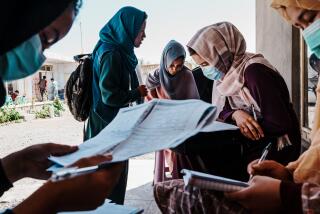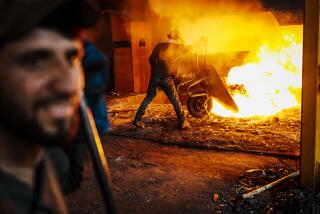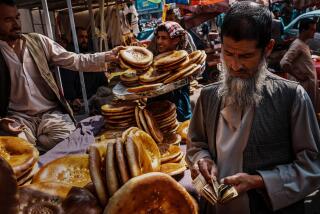U.S. Ambassador Receives Promise of Peace Talks in Visit to Afghanistan
- Share via
KABUL, Afghanistan — Bill Richardson, the U.S. ambassador to the United Nations, flew into this untamed, shattered land Friday and came away with a promise from its competing warlords to talk peace for the first time in more than a year.
Richardson, the highest-ranking American diplomat to visit Afghanistan since 1974, said he hoped that the agreement secured from the ruling Taliban militia and the main rebel groups would end fighting that has dragged on for more than 20 years, defied numerous mediators and left more than 1 million people dead.
Beyond an agreement to begin talks, Richardson’s accord contained few details--and little evidence that either side was willing to share power.
Minutes after he departed from the headquarters of rebel general Abdul Rashid Dostum, the two sides began shelling each other--with the spectacular nighttime bursts visible from Richardson’s plane.
Still, Richardson said he was hopeful that the Afghan people were so fed up with fighting that they might--with high-profile prodding from the United States--finally be willing to silence their guns.
“I believe the Afghan people want this war to end. I saw it in their eyes,” he said afterward in Islamabad, Pakistan. “It appears we have a breakthrough.”
Richardson, the globe-trotting envoy known for his savvy in Third World crises, hopscotched across this country in a small, propeller-driven plane, from the ruins of central Kabul to the steppes of northern Afghanistan.
In Kabul, he drove through a city that appeared more moonscape than metropolis, where the population lives and sleeps amid the rubble. In Sheberghan, in northern Afghanistan, he was welcomed by ethnic Uzbek horsemen frolicking at bazkashi, a traditional polo-like game played with the carcass of a beheaded goat.
“I welcome Ambassador Richardson to Afghanistan,” said Dostum, the battle-hardened leader of the Junbush-i-Milli party, from the tarmac of his remote air base. “We are honored to have a top American here after so many years.”
Richardson said he came to Afghanistan to jump-start a U.N.-sponsored peace process that had sputtered.
He said his visit highlighted a renewed American interest in the region, which has long been overlooked by U.S. diplomats.
“We the United States are prepared to engage intensively in Afghanistan in this search for peace,” he said.
At the end of the day, the Taliban government and its four main rivals agreed to meet face-to-face sometime in the next 10 days. They promised not to launch any fresh offensives in the meantime--though they left open the option of dueling with artillery.
The Taliban, which captured the capital, Kabul, in 1996, now controls more than two-thirds of Afghanistan. Three of the main rebel groups, which often battle one another, have fought the Taliban to a stalemate along a front north of Kabul. The fourth group holds out in the mountains west of the capital.
The Taliban government also agreed in principle to lift its siege of the Bamian region, where tens of thousands of people are threatened with starvation. But the Taliban would not say how, when or where they would allow food to enter--only that they would talk about it when negotiations resumed.
Taliban leaders, led by Mullah Mohammed Rabbani, also promised to stop harassing U.N. relief workers, to allow female doctors to treat women and girls, and to provide greater educational opportunities for women. They pledged to release a number of prisoners of war but did not say how many.
U.N. teams were to fly in next week to try to pin down both sides on details. The meeting between the Taliban and the rebels would be held in neighboring Pakistan.
U.S. officials said they found the Taliban leadership surprisingly receptive.
“This time they listened--that’s the important thing,” Assistant Secretary of State Karl Inderfurth said. “Usually they just give you a long lecture.”
In Kabul, Taliban spokesman Wakil Ahmad Mutawakel confirmed that his side had agreed to talks.
In Sheberghan, Richardson met with Dostum, Shiite faction leader Karim Khalili and former President Burhanuddin Rabbani.
“Fighting is not the solution,” the general said.
Richardson’s venture into Afghanistan marked the first official U.S. effort to end a war that has defied solution for two decades.
Afghanistan has been at war since 1978. A year later the Soviet Union invaded.
With the help of massive, covert American intervention, the Afghans forced the Soviets to withdraw in 1989.
Since then, the Afghans have set upon themselves.
The civil war has pitted the ethnic Pushtuns, who have long dominated the country and make up the majority of the Taliban, against the ethnic Uzbeks, Tajiks and other minorities.
In 1996, the Taliban, fired by a fundamentalist Islamic creed, swept into Kabul and imposed a strict brand of rule that has touched nearly every aspect of everyday life.
The Taliban have closed schools for girls, prohibited women from working and from walking alone in public. Men must grow beards and trim their hair--and if they don’t, squads from the General Department for the Preservation of Virtue that roam the city in Toyota pickups do it for them. Kite flying and playing marbles, traditional forms of recreation in Afghanistan, have been banned, as have dancing and music.
Two weeks ago, Taliban men cut off the hand of a suspected thief before a large crowd at the Kabul Sports Stadium.
Though public executions are usually carried out on Fridays, none were scheduled the day of Richardson’s visit.
He began his day laying a wreath at a memorial to Adolph Dubs, the former U.S. ambassador who was kidnapped and killed Feb. 14, 1979.
Richardson also held a public ceremony for the 54 local employees who still maintain the bullet-riddled U.S. Embassy, closed since 1989.
Wherever Richardson went Friday, he found the scars of war and a yearning for peace.
In Kabul, children played amid crumbled buildings while Taliban soldiers--with grenade launchers strapped to their backs--directed traffic. Men and women spoke of having to sleep in bombed-out buildings and of the rising prices that have made bread unaffordable.
Shah Khukhu, 50, a mother of five, hobbled around amid the bombed-out buildings searching for something to eat. Five years ago, she stepped on a land mine that blew off her right leg and a finger on her right hand. Khukhu said she had heard nothing of Richardson’s trip but prayed daily for an end to the fighting.
“We must have peace in this country,” she said, “or else everyone is going to die.”
Some of the women in Kabul complained about restrictions imposed by the Taliban. Others defended the practices, saying they were keeping in line with Afghan and Islamic tradition.
Bibi Zada, 35, walked the streets, her body, face and hair hidden behind her burka.
Zada said she did not mind the traditional enveloping garb but worried whether she would ever be able to send her seven children to school.
“We don’t want anything--just peace,” said Zada, whose two brothers were killed in fighting. “With peace, we can rebuild our homes. We can send our children to school.”
In Sheberghan, Habiba Amiri, a physician, wondered whether ethnic Tajiks like her would ever be able to get along with the Taliban and other ethnic Pushtuns.
Amiri fled Kabul in 1996 when the Taliban moved in, fearing that she would no longer be able to practice medicine. “The women here are afraid of the Taliban,” she said. “They know that with the Taliban, there would be nothing for them.”
It is that kind of enmity and fear that Richardson said negotiators must overcome.
On Friday, after years of fighting in Afghanistan, he asked people not to expect a miracle overnight.
“In this business,” he said, “we make peace one day at a time.”
More to Read
Sign up for Essential California
The most important California stories and recommendations in your inbox every morning.
You may occasionally receive promotional content from the Los Angeles Times.










